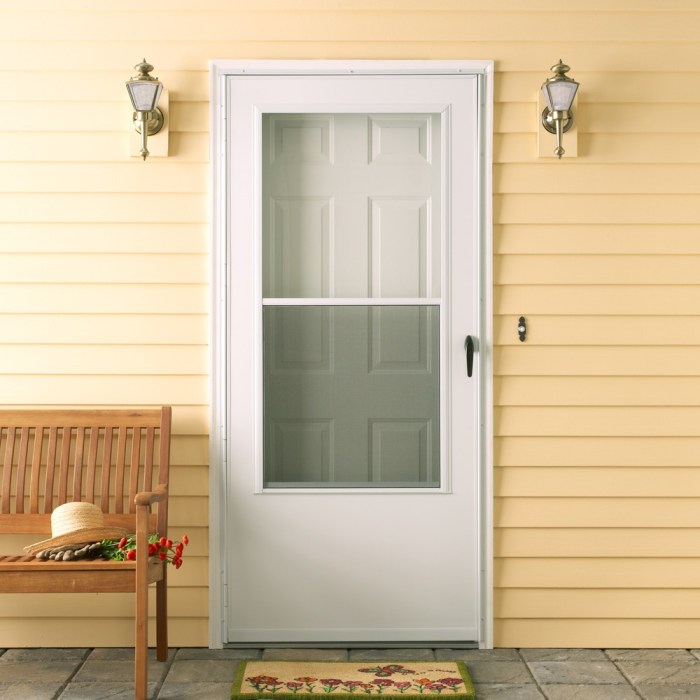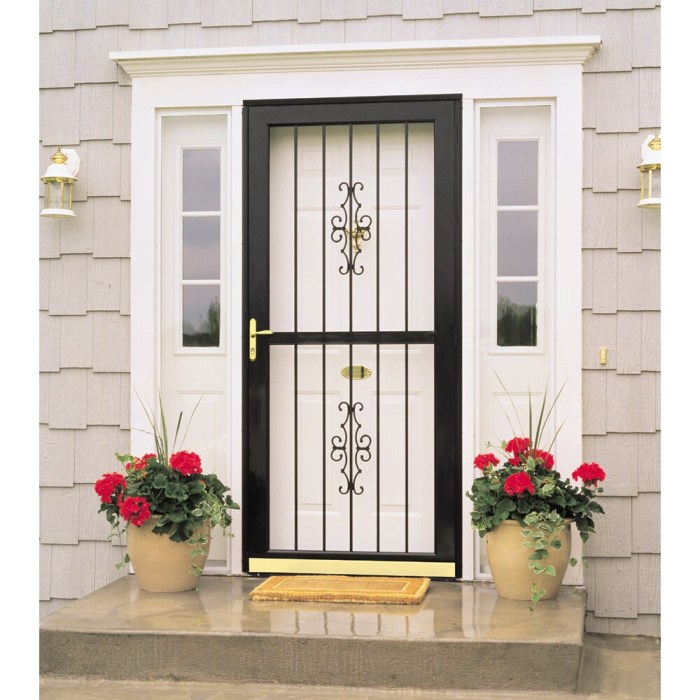Decorative storm doors: They’re more than just a barrier against the elements; they’re a statement piece, a chance to inject personality and style into your home’s exterior. From classic elegance to modern minimalism, the options are vast and varied. This comprehensive guide delves into the world of decorative storm doors, exploring the diverse styles, materials, installation processes, and design considerations to help you make an informed decision that perfectly complements your home’s architecture and enhances its overall aesthetic appeal.
We’ll examine the various materials available, from durable fiberglass and weather-resistant metal to the timeless charm of wood. We’ll also cover design styles, including traditional, modern, and Victorian options, and explore the features that elevate these doors to true decorative masterpieces, such as intricate glass panels, stylish hardware, and a range of paint finishes. Beyond aesthetics, we’ll discuss energy efficiency, security enhancements, and the all-important cost considerations to help you find the perfect storm door to meet your needs and budget.
Installation and Maintenance of Decorative Storm Doors

Installing and maintaining a decorative storm door correctly ensures its longevity and enhances your home’s curb appeal. Proper installation prevents drafts and protects your main door, while regular maintenance preserves its beauty and functionality. Understanding the process and necessary steps is crucial for achieving optimal results.
Storm Door Installation Process
The installation of a decorative storm door is a moderately challenging DIY project, manageable with the right tools and a methodical approach. Improper installation can lead to air leaks, security vulnerabilities, and damage to the door itself. Therefore, following these steps is essential for a successful outcome.
- Preparation: Measure your existing door precisely to ensure the storm door fits correctly. Gather necessary tools: measuring tape, level, drill, screwdriver, safety glasses, work gloves, shims, and appropriate fasteners (screws or bolts) specified by the manufacturer.
- Frame Preparation: Carefully examine the existing door frame for any damage or obstructions. Clean the frame thoroughly to ensure a secure seal. If necessary, repair any damage before proceeding.
- Installing the Frame: Position the storm door frame according to the manufacturer’s instructions, ensuring it is plumb and level. Use shims to adjust for any inconsistencies in the existing frame. Secure the frame to the existing door frame using the provided fasteners.
- Hanging the Door: Carefully hang the storm door onto the installed frame, ensuring the hinges align correctly. Adjust as needed to ensure smooth operation.
- Final Adjustments: Once the door is hung, check for proper alignment and operation. Make any necessary adjustments to ensure the door closes and latches securely. Install the handle and any other necessary hardware.
- Weatherstripping: Apply weatherstripping around the perimeter of the storm door to create an airtight seal, preventing drafts and energy loss. This step is crucial for maximizing the door’s effectiveness.
Storm Door Maintenance Tips
Regular maintenance is vital to prolong the life and beauty of your decorative storm door. Neglecting maintenance can lead to damage, reduced functionality, and costly repairs. A proactive approach can significantly extend the lifespan of your investment.
- Regular Cleaning: Clean the door regularly to remove dirt, debris, and grime. The frequency depends on your climate and the door’s exposure to the elements. A simple cleaning can prevent significant damage.
- Lubrication: Lubricate the hinges and latch mechanism periodically to ensure smooth operation and prevent squeaking. A light spray lubricant is usually sufficient.
- Inspect for Damage: Regularly inspect the door for any signs of damage, such as cracks, scratches, or loose hardware. Address any issues promptly to prevent further damage.
- Seasonal Adjustments: Adjust the door’s alignment and weatherstripping as needed throughout the year, especially during seasonal changes. This ensures a consistently tight seal.
- Protect from Extreme Weather: Take precautions to protect the door from extreme weather conditions, such as heavy snow or intense sun exposure. Consider using protective covers during harsh weather.
Cleaning and Caring for Different Storm Door Materials
Different storm door materials require specific cleaning methods to maintain their appearance and prevent damage. Using inappropriate cleaning agents can cause discoloration or deterioration.
- Aluminum Storm Doors: Clean with a mild soap and water solution. Avoid abrasive cleaners or harsh chemicals. A soft cloth or sponge is recommended. Aluminum is relatively durable, but scratches can still occur.
- Fiberglass Storm Doors: Similar to aluminum, clean with mild soap and water. Fiberglass is more resistant to scratches but should still be cleaned gently. Avoid harsh chemicals or abrasive pads.
- Wood Storm Doors: Wood storm doors require more specialized care. Clean with a wood cleaner specifically designed for exterior use. Regularly apply a protective sealant to prevent water damage and maintain the finish. Wood is more susceptible to damage from moisture and extreme temperatures.
- Steel Storm Doors: Clean with a mild soap and water solution. Steel is relatively durable, but rust can be a concern. Ensure the door is properly sealed and protected from moisture.
Cost Considerations and Purchasing Advice: Decorative Storm Doors

Investing in a decorative storm door is a significant home improvement project, and understanding the associated costs is crucial for making an informed decision. The price varies considerably depending on several factors, including material, style, size, features, and installation. Careful planning and comparison shopping will ensure you get the best value for your investment.
The total cost encompasses not only the door itself but also professional installation, which is often recommended to guarantee proper fit and functionality. Failing to account for installation costs can lead to unexpected expenses and potentially compromise the door’s performance and longevity. Therefore, a realistic budget should include both the door’s purchase price and the installation fee.
Price Ranges for Decorative Storm Doors
Prices for decorative storm doors range widely. A basic, entry-level model made of fiberglass or aluminum might cost between $300 and $800. More elaborate designs, featuring intricate glass panels, wood frames, or advanced features like integrated blinds or enhanced insulation, can easily reach $1,000 to $3,000 or more. Custom-made doors, especially those with unique designs or non-standard sizes, will typically fall at the higher end of this spectrum.
For example, a high-end, handcrafted solid wood storm door with intricate glasswork and custom finishes could easily exceed $4,000. These prices generally exclude professional installation, which can add another $200 to $800 depending on location and installer.
Finding Reputable Dealers and Installers
Choosing a reputable dealer and installer is essential for ensuring a smooth installation process and a long-lasting, well-functioning storm door. Start by seeking recommendations from friends, family, or neighbors who have recently had storm doors installed. Online reviews on sites like Yelp, Angie’s List, or HomeAdvisor can also provide valuable insights into the experiences of other customers. Check the Better Business Bureau (BBB) for any complaints or ratings related to potential dealers and installers.
Verify that the chosen installer is licensed and insured to protect yourself against potential liabilities. Inquire about warranties offered both on the door itself and the installation service.
Comparing Prices and Features for Informed Decision-Making, Decorative Storm Doors
Before making a purchase, compile quotes from at least three different dealers or installers. Carefully compare not only the price but also the features included, such as the type of material (fiberglass, wood, aluminum), glass type (insulated, tempered, decorative), hardware quality, and any additional features like built-in blinds or screens. Consider the energy efficiency ratings to assess potential savings on heating and cooling costs.
A detailed comparison chart can be a useful tool to organize this information. For example, create a table with columns for dealer name, price, material, features, warranty, and installation cost. This systematic approach allows for a clear and objective comparison, leading to a more informed purchasing decision. Remember that the cheapest option isn’t always the best; a slightly more expensive door with superior quality and longer lifespan can be a more cost-effective choice in the long run.
Choosing the right decorative storm door is a significant decision, impacting both the functionality and curb appeal of your home. By carefully considering the factors Artikeld in this guide – from material and style to installation and maintenance – you can confidently select a door that enhances your home’s beauty, security, and energy efficiency for years to come. Remember to weigh the pros and cons of each material and style, considering your home’s architecture and your personal aesthetic preferences.
With a little planning and research, you can transform your entryway into a stunning focal point that reflects your unique style and adds significant value to your property.